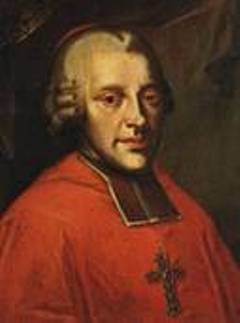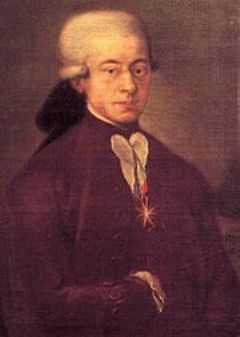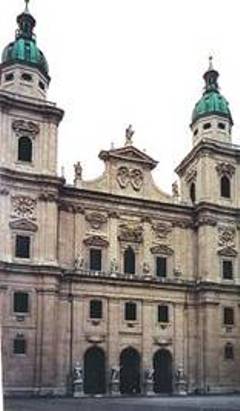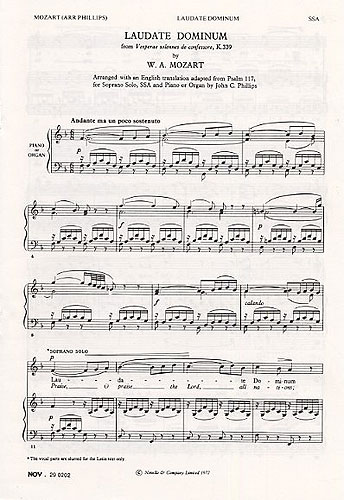Laudate Dominum
| Classical Notes |
In 1773 Mozart became employed as a member of the music ensemble in the residence of the Prince Archbishop of Salzburg Hieronymus Colloredo. In Salzburg he had many friends and admirers, he was the city’s favourite musician. Despite his artistic successes Mozart began to think about looking for better opportunities elsewhere, as the time passed. He was unsatisfied with his income of 150 florins per year. In 1775 the court’s theatre was closed down and Mozart, who planned to compose great operas, was not pleased. His dissatisfaction with Salzburg was growing.
Eventually in September 1777 he left for Paris, traveling with his mother via Augsburg and Mannheim. The trip did not meet his expectations. He fell into financial difficulties. His mother became seriously ill. Her treatment was delayed by the length of time required to gather sufficient funds, which resulted in her death in the beginning of July. Concerned Leopold Mozart made energetic efforts to find better employment conditions for his son. He managed to make the post of the main organist in the Archbishop’s court available to Wolfgang, with the yearly salary of 450 florins.
Vesperae Solennes de Confessore
Laudate Dominum
Mozart, however, was reluctant to go back. He searched for better luck in Mannheim and Munich. After little success, he was forced to make a humiliating retreat and in 1779 he returned to Salzburg. The new contract required from him little more than the normal activities of the court’s organist. He was expected to compose a few religious pieces. The Archbishop wished one of them to be suitable for afternoon or evening ceremonies.

Prince-Archbishop Hieronymus Graf von Colloredo
Mozart quite quickly completed the task. In the spring of 1779 he wrote Vesperae Solennes de Dominica K.321. Vesperae is a mass or ceremony that should be held late in the afternoon or early in the evening. Solennes (Solemn) has many meanings. In this case it is the most sensible to translate it as “holy day”. Thus, Vesperae solennes de Dominica is meant to be performed on a Sunday afternoon or evening (dominica = Sunday).
Mozart, of course, based the composition on the Catholic liturgy. It consists of five Psalms and Magnificat. The Psalms come from the collection numbered 109 – 140 according to Vulgata. Magnificat from Luke 1.46-55. The first four Psalms were an obligatory part of evening ceremonies in the Catholic convents. The framework of the composition is as follows:
• Dixit Dominus (Vulgate 109)
• Confitebor (110)
• Beatus vir (111)
• Lauda pueri (112)
• Laudate Dominum (116)
• Magnificat – anima mea.

Portrait of Mozart in 1777
The following year Mozart composed Vesperae solennes once more. The structure remained the same, but the purpose was different. This time it was not intended for just any Sunday, but for a specific holiday. The piece was entitled Vesperae Solennes de Confessore K.339.
The term ‘confessor’ refers to the Saints, who were not Apostles, martyrs or monastery abbots. The most significant confessors were St. Joseph and St. Francis. Many of these Saints were bishops. This was the case Mozart had in mind. Vesperae Solennes de Confessore was created for a specific day – the 24th of September. The day was assigned to St. Rupert, the co-patron saint of the Salzburg Cathedral and the patron of the whole region. The other patron of the Cathedral was St. Virgil.
St. Rupert was the bishop of a German town called Worms. In 696 the Prince of Bavaria Theodo invited Rupert to teach him religious faith. Rupert fulfilled the Prince’s expectations. In the following year he traveled to Bavaria to spread the word of God. He reached as far as the ruins of the old Roman town Juvavia. Theodo agreed to finance the construction of religious buildings, which Rupert intended to erect in that place. St. Peter’s Church and Nonnburg Abbey and monastery were build there. Today it is the oldest monastery complex in the German – speaking world.
The town of Salzburg was built around the Benedictine Monastery. Rupert died in 718. After his death the construction of the Cathedral began. The work was completed by Bishop Virgil in 774. On the 24th of September the Cathedral was ordained to St. Rupert. In memory of this event Ruperti Kirtag is celebrated every year in the whole Salzburg province.

The Salzburg Cathedral
It was the same in the times of Mozart. Confessore referred to St. Rupert. There is no record of the first and further performances of Vesperae Solennes de Confessore. The piece, however, must have been quite well known. In 1781, when Mozart was already in Vienna, he asked his father in a letter to send him both versions of Vesperae Solennes. Baron von Swieten wanted to listen to them.
Both versions of Veaperae were written for SATB (Soprano, Alto, Tenor, Bass), choir and orchestra made up of strings, bassoon, two trumpets, three trombones and organs.
The music in Vesperae Solennes is quite rigid, perhaps due to the character of the Psalms. In any case, Mozart applied a rather old style …… It stands out from the remaining Psalms with its uniqueness and beauty.
Laudate Dominum.
This Psalm emanates unwavering calmness and is as magical as another already described by me miniature Ave Verum Corpus. Mozart’s religious devotion was rather questionable, but his church compositions are magnificent.
Albert Einstein loved Laudate Dominum. He also valued both Vesperae Solennes. He once expressed it by saying: “Whoever doesn’t know these works, doesn’t know Mozart”.

In music box Vesperae Solennes de Confessore by the Symphony Orchestra of the Soviet Union conducted by Rożdziestwieński – a really good performance.
Last Updated (Monday, 16 March 2015 20:17)
